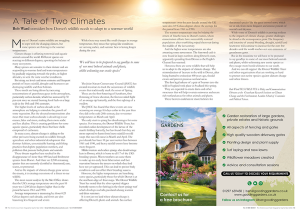Bob Ward considers how Dorset’s wildlife needs to adapt to a warmer world

Many of Dorset’s native wildlife are struggling to cope with the changing climate, but some species are thriving in the warmer temperatures.
Climate change is affecting terrestrial and aquatic animals around the world. Different species are reacting to different degrees, upsetting the balance of many ecosystems.
Many species are sensitive to their climate and are responding to warmer land and water temperatures by gradually migrating towards the poles, or higher altitudes, to seek the same weather conditions.
But rising sea levels and more extreme and frequent periods of heavy rainfall, drought and heatwaves are destroying wildlife and their habitats.
These trends are being driven by increasing concentrations of greenhouse gases in the atmosphere, particularly carbon dioxide, which has increased by 50 per cent since we started burning fossil fuels on a large scale in the 18th and 19th centuries.
The higher levels of carbon dioxide in the atmosphere are helping to stimulate the growth of some vegetation. But the elevated concentrations also mean that more carbon dioxide is dissolving in our oceans, lakes and rivers, making them more acidic and less alkaline. This is creating problems for some aquatic species, particularly those that have shells composed of carbonate.
In many cases, climate change is adding to the other pressures being exerted on wildlife through agriculture and other industrial development that destroys habitats, unsustainable hunting and fishing practices that deplete population numbers, and pollution that poisons both plants and animals.
These threats together have resulted in the disappearance of more than 400 land and freshwater species from Dorset. And there are 2,500 remaining species that are currently classified as threatened, rare, scarce, or protected.
And as the impacts of climate change grow across the county, it is creating even more of a threat to our wildlife.
The most recent analysis by the Met Office shows that the UK’s average temperature over the past 10 years was 1.24 Celsius degrees higher than in the period between 1961 and 1990.
Average temperature is increasing by about 0.25 Celsius degrees each decade, and frosts are also becoming less frequent and severe.
While these may sound like small changes in average temperature, they mean that spring-like conditions are arriving earlier, and summer heat is lasting longer during the year.
The Joint Nature Conservancy Council (JNCC) has created monitors to track the occurrence of wildlife events that traditionally mark the onset of Spring.
These are the first flowering of hawthorn, first flowering of horse chestnut, the first recorded flight of an orange-tip butterfly, and the first sighting of a swallow.
The JNCC has found that these events are now occurring on average 8.6 days earlier in the year than they did in the early 20th century, due to warmer temperatures in March and April.
The early start to spring has disadvantages for some species. For instance, the Dorset Wildlife Trust, has recorded earlier development of the larvae of the marsh fritillary butterfly, but has found that they are more exposed to harm from heavy rainfall or cold snaps that can still occur in March and April. The past decade has been 10 per cent wetter than between 1961 and 1990, and heavy rainfall events have become more frequent.
Milder winters and earlier springs also disadvantage bats in Dorset, which is home to all 17 of the UK’s breeding species. Warm weather can cause them to wake up too early from hibernation and face starvation because the insects on which they feed have not yet appeared. This can lead to poorer body conditions and can affect their breeding success.
However, the higher temperatures are benefiting some species, particularly those for which Dorset is at the northern edge of their range. The Dorset Wildlife Trust has noted that the silver-spotted skipper butterfly seems to be thriving in the short springy turf which develops in chalk grasslands during warmer and drier summers.
It is not just on land where climate change is affecting Dorset’s plants and animals. Sea surface temperatures over the past decade around the UK were also 0.9 Celsius degrees above the average for the period from 1961 to 1990.
The warmer temperatures may be helping the return of bluefin tuna to Dorset’s waters, where conservation efforts have successfully restored populations after overfishing wiped them out during the middle of the last century.
And the higher water temperatures are also attracting some newcomers. The furrowed crab is now found in large numbers along Dorset’s coast, apparently spreading from Devon as the English Channel has warmed.
However, there are some wildlife that will help us to adapt to the impacts of climate change. The reintroduction of beavers in the wild in Dorset, after being hunted to extinction 400 years ago, should create and protect precious wetland areas.
The first legal release of a pair of beavers into the wild in England took place in Studland this spring.
They are expected to create dams and other structures that will help to retain rainwater and create rich wetland areas for other animals and plants.
These beavers could create more habitats for threatened species like the great crested newt, which are at risk from more frequent and intense periods of warmth and dryness.
While some of Dorset’s wildlife is proving resilient to the impacts of climate change, greater challenges lie ahead as the consequences grow. The frequency and intensity of coastal flooding, drought, rainfall and heatwaves will continue to increase for the next few decades until the world reaches net zero emissions of greenhouse gases.
But in the meantime we will have to be prepared to say goodbye to some of our most beloved animals and plants, whilst welcoming new exotic species as they escape more hostile climates to our south.
And we can all support the Dorset Wildlife Trust and other organisations that are working so hard to protect our native species against climate change and other threats.



